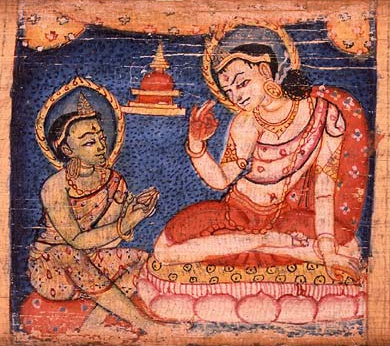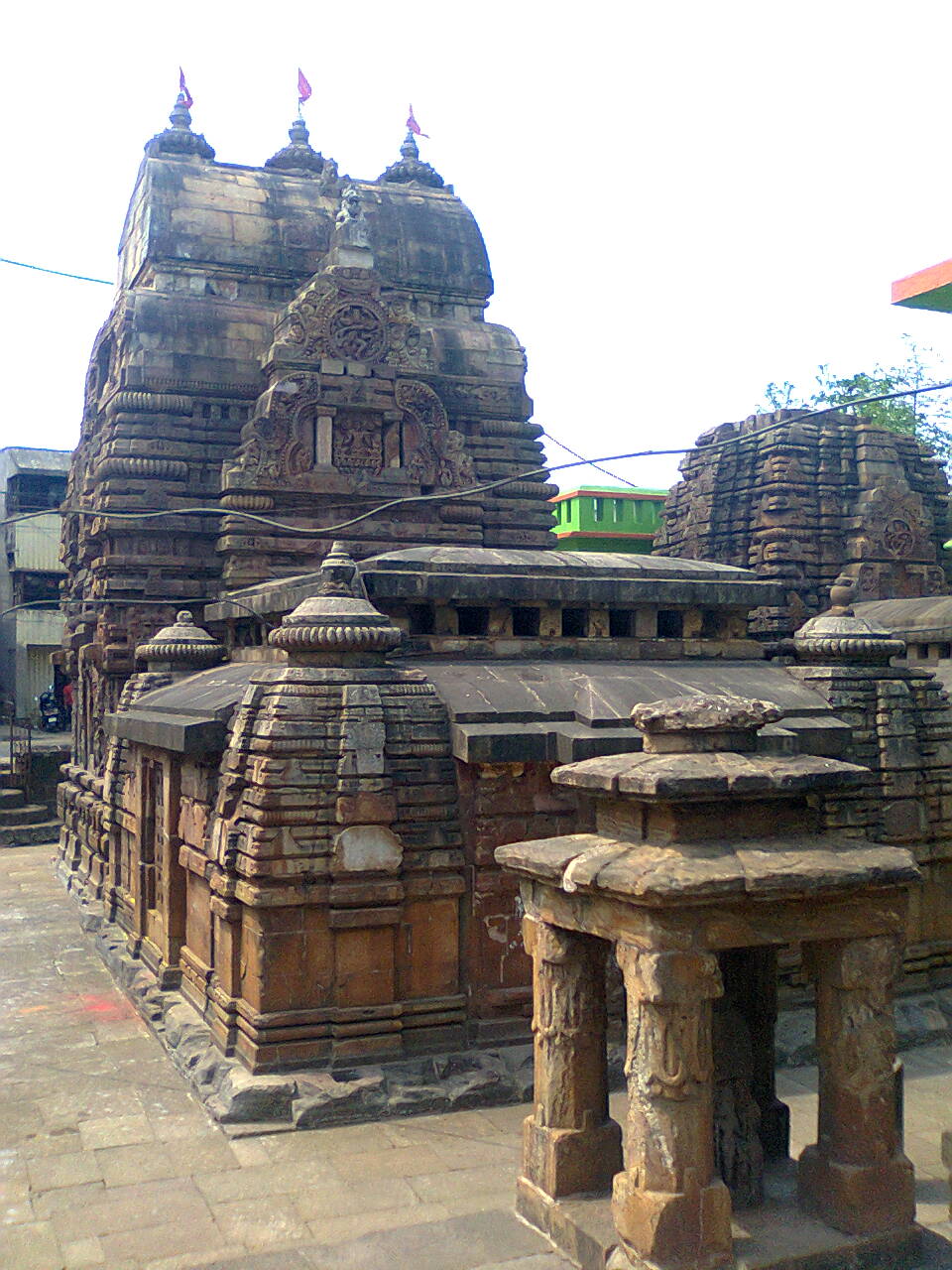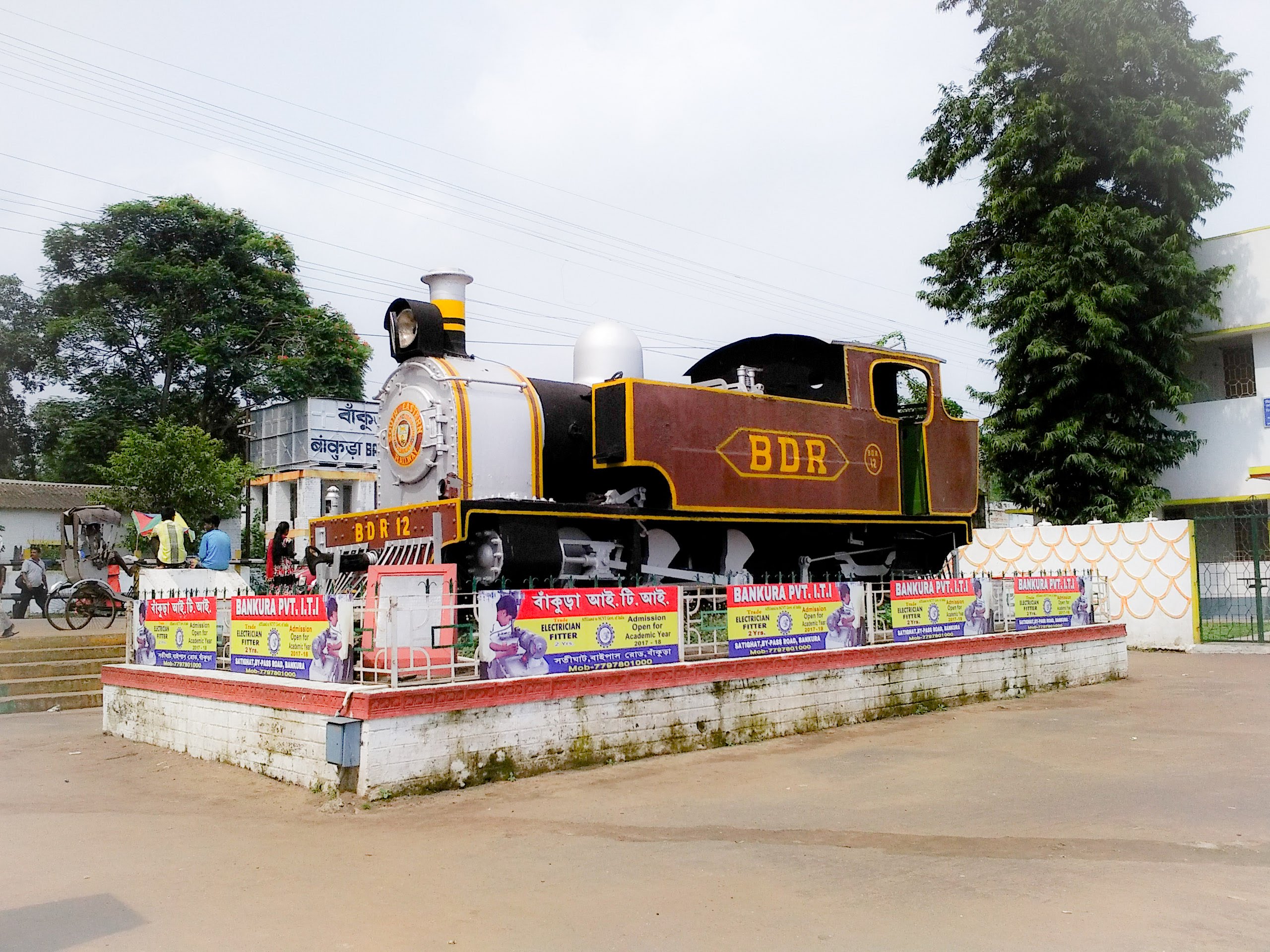|
Sivakara Deva I
Maharaja Sivakara Deva I or Sivakara Unmattasimha/ Unamattakeshari was a powerful monarch of the Bhaumakara dynasty who ruled in the late tertiary part of the 8th century A.D. He was the descendant of Ksemankara Deva who is believed to be the founder of the Bhaumakara rule in ancient Odra and also the earliest organizer of the Varna system in the region. Sivakara Deva I pursued a career of conquest in the eastern part of India establishing the Bhaumakaras as the supreme power in the whole region during his lifetime. He conquered the kingdom of Radha(Rarh) in present-day West Bengal defeating probably the Pala king Dharmapala and subjugated the Eastern Ganga rulers of Kalinga as his vassals. With these conquests his empire stretched from modern Bardhaman district of Bengal to Godavari river in south. He was a devout Buddhist who in 790 built the Sholampura Buddha Vihara and who adopted the epithets of Paramopasaka and Paramatathgata meaning a devout worshiper of Buddha which has b ... [...More Info...] [...Related Items...] OR: [Wikipedia] [Google] [Baidu] |
Rarh
Rarh region () is a toponym for an area in the Indian subcontinent that lies between the Chota Nagpur Plateau on the West and the Ganges Delta on the East. Although the boundaries of the region have been defined differently according to various sources throughout history, it is mainly coextensive with the state of West Bengal, also comprising parts of the state of Jharkhand in India. Linguistically, the region is defined with population speaking the Rarh kudmali local dialect. The Rarh region historically has been known by many different names and has hosted numerous settlements throughout history. One theory identifies it with the powerful Gangaridai nation mentioned in the ancient Greco-Roman accounts. An inscription of Vallalasena names it as the ancestral place of the Sena dynasty. Etymology and names (Sanskrit) and (Prakrit) are the ancient names of the Rarh region. Other variations of the name that appear in the ancient Jain literature include Rarha, Lara, and Rara ... [...More Info...] [...Related Items...] OR: [Wikipedia] [Google] [Baidu] |
Midnapore District
Midnapore district was a district of the state of West Bengal, India. This district was bifurcated on 1 January 2002 into the Purba Medinipur district and the Paschim Medinipur district. On 4 April 2017, the Jhargram subdivision of Paschim Medinipur district (which formed part of the undivided Midnapore district) was converted into Jhargram district. Demographics See also * Midnapore town *Partition of Midnapore Partition may refer to: Computing Hardware * Disk partitioning, the division of a hard disk drive * Memory partition, a subdivision of a computer's memory, usually for use by a single job Software * Partition (database), the division of a ... References Former districts of West Bengal {{WestBengal-geo-stub ... [...More Info...] [...Related Items...] OR: [Wikipedia] [Google] [Baidu] |
Ratnagiri, Odisha
Ratnagiri (Odia: ରତ୍ନଗିରି, meaning "hill of jewels") is the site of a ruined mahavihara, once the major Buddhist monastery in modern Odisha, India. It is located on a hill in between the Brahmani and Birupa rivers in Jajpur district. It is close to other Buddhist sites in the area, including Lalitagiri and Udayagiri, and from the state capital Bhubaneswar and 70km from the former state capital Cuttack. The Buddhist monuments were constructed from the 5th century CE onwards, with the last work in the 13th century, and the peak period of work done between about the 7th to 10th centuries. After perhaps the 16th century the site ceased to be used and fell into ruins. These were little known until the 1960s when major campaigns of excavations by the Archaeological Survey of India ("ASI") revealed the site, producing large quantities of very fine sculpture. Monastery 1 has been described as "the finest in terms of carved stone decoration to have survived in India". ... [...More Info...] [...Related Items...] OR: [Wikipedia] [Google] [Baidu] |
Tang Dynasty
The Tang dynasty (, ; zh, t= ), or Tang Empire, was an Dynasties in Chinese history, imperial dynasty of China that ruled from 618 to 907 AD, with an Zhou dynasty (690–705), interregnum between 690 and 705. It was preceded by the Sui dynasty and followed by the Five Dynasties and Ten Kingdoms period. Historians generally regard the Tang as a high point in Chinese civilization, and a Golden age (metaphor), golden age of cosmopolitan culture. Tang territory, acquired through the military campaigns of its early rulers, rivaled that of the Han dynasty. The House of Li, Lǐ family () founded the dynasty, seizing power during the decline and collapse of the Sui Empire and inaugurating a period of progress and stability in the first half of the dynasty's rule. The dynasty was formally interrupted during 690–705 when Empress Wu Zetian seized the throne, proclaiming the Zhou dynasty (690–705), Wu Zhou dynasty and becoming the only legitimate Chinese empress regnant. The devast ... [...More Info...] [...Related Items...] OR: [Wikipedia] [Google] [Baidu] |
Gandavyuha
The ''Gaṇḍavyūha Sutra'' (Tib. ''sdong po bkod pa'i mdo'') is a Buddhist Mahayana Sutra of Indian origin dating roughly c. 200 to 300 CE.Osto, Douglas. The Gaṇḍavyūha-sūtra: a study of wealth, gender and power in an Indian Buddhist Narrative, 2004, pg 60 The term ''Gaṇḍavyūha'' is obscure and has been translated variously as ''Stem Array, Supreme Array, Excellent Manifestation''.'''' The Sanskrit ''gaṇḍi'' can mean “stem” or “stalk” and “pieces” or “parts” or “sections,” as well as "the trunk of a tree from the root to the beginning of the branches")''.'' Peter Alan Roberts notes that "as the sūtra is composed of a series of episodes in which Sudhana meets a succession of teachers, the intended meaning could well have been 'an array of parts' or, more freely, 'a series of episodes."'' He also notes that the term gaṇḍa can also mean "great" or "supreme" in some circumstances and thus some translators have rendered this compound as ''Supreme ... [...More Info...] [...Related Items...] OR: [Wikipedia] [Google] [Baidu] |
Godavari River
The Godavari (IAST: ''Godāvarī'' �od̪aːʋəɾiː is India's second longest river after the Ganga river and drains into the third largest basin in India, covering about 10% of India's total geographical area. Its source is in Trimbakeshwar, Nashik, Maharashtra. It flows east for , draining the states of Maharashtra (48.6%), Telangana (18.8%), Andhra Pradesh (4.5%), Chhattisgarh (10.9%) and Odisha (5.7%). The river ultimately empties into the Bay of Bengal through an extensive network of tributaries. Measuring up to , it forms one of the largest river basins in the Indian subcontinent, with only the Ganga and Indus rivers having a larger drainage basin. In terms of length, catchment area and discharge, the Godavari is the largest in peninsular India, and had been dubbed as the Dakshina Ganga (Ganges of the South). The river has been revered in Hindu scriptures for many millennia and continues to harbour and nourish a rich cultural heritage. In the past few decades, the riv ... [...More Info...] [...Related Items...] OR: [Wikipedia] [Google] [Baidu] |
Rushikulya
The Rushikulya River is one of the major rivers in the state of Odisha and covers entire catchment area in the districts of Kandhamal and Ganjam of Odisha. The Rushikulya originates at an elevation of about 1000 metres from Daringbadi hills of the Eastern Ghats range. The place from where the river originates, Daringbadi is called the ' Kashmir of Odisha '. The river lies within the geographical coordinates of 19.07 to 20.19 north latitude and 84.01 to 85.06 east longitude. It meets the Bay of Bengal at Puruna Bandha in Ganjam. Its tributaries are the Baghua, the Dhanei, the Badanadi etc. It has no delta as such at its mouth. River course The river flows from the Daringbadi hill station in Kandhamal district. In the Ganjam district it flows through Surada, Dharakote, Asika, Pitala, Purusottampur, Taratarini, Pratappur, Alladigam, Brahmapur, Ganjam and the Chhatrapur block. The river is 165 km long with a total catchment area of 7700 km2. The mean monthly flow rate is ... [...More Info...] [...Related Items...] OR: [Wikipedia] [Google] [Baidu] |
Tribhuvana Mahadevi I
Paramavaishnavi Goswamini Devi or Tribhuvana Mahadevi I (Odia: ପ୍ରଥମ ତ୍ରିଭୁବନ ମହାଦେବୀ) was the first female ruler of the Bhaumakara Dynasty in ancient Odisha and the widow of king Santikara I who ascended the throne of Toshali or Utkala between the years 843 A.D to 845 A.D and ruled until 850 A.D after the premature death of her ruling son Subhakara III. Some historians believe that she might have ruled as long as 863 A.D abdicating the throne for her grandson Santikara II after he turned older and eligible to run the administration. She was a very powerful female ruler and found appreciating mentions as a beholder of lavish power and prestige by the Arab and Persian geographer Ibn Khordadbeh and explorer Ahmad Ibn Rustah. She rose to power despite feudal kings of coastal-central parts of erstwhile Tri-Kalinga region rebellions and with the help her powerful father. She compared herself with the Goddess Katyayani (a form of Goddess Shakti) w ... [...More Info...] [...Related Items...] OR: [Wikipedia] [Google] [Baidu] |
Dhenkanal District
Dhenkanal district is one of the 30 districts of the state of Odisha in Eastern India. Geography Dhenkanal district is one of the centrally located districts in Odisha. It lies between Longitude: 85° 58' to 86° 2' East and Latitude: 20° 29' to 21° 11' North. The nearest airport is Biju Patnaik Airport located at a distance of 52.12 Km. It is bordered by Kendujhar and Angul districts to the north, Jajpur district to the east, Cuttack district to the south and Angul district to the west. The district comprises mainly plains, however there are several discontinuous hill ranges in the district and along its southern border. The Brahmani River is the main river of the district. Demographics According to the 2011 census Dhenkanal district has a population of 1,192,811, roughly equal to the nation of Timor-Leste or the US state of Rhode Island. This gives it a ranking of 400th in India (out of a total of 640). The district has a population density of . Its population ... [...More Info...] [...Related Items...] OR: [Wikipedia] [Google] [Baidu] |
Bankura District
Bankura district (Pron: bãkuɽa) is an administrative unit in the Indian state of West Bengal. It is part of Medinipur division—one of the five administrative divisions of West Bengal. Bankura district is surrounded by Purba Bardhaman district and Paschim Bardhaman district in the north, Purulia district in the west, Jhargram district and Paschim Medinipur district in the south, and some part of Hooghly district in the east. Damodar River flows in the northern part of Bankura district and separates it with the major part of Burdwan district. The district head quarter is located in Bankura town. The district has been described as the "connecting link between the plains of Bengal on the east and Chota Nagpur plateau on the west." The areas to the east and north-east are low-lying alluvial plains while to the west the surface gradually rises, giving way to undulating country, interspersed with rocky hillocks.O’Malley, L.S.S., ICS, ''Bankura'', Bengal District Gazetteers, pp. ... [...More Info...] [...Related Items...] OR: [Wikipedia] [Google] [Baidu] |
Bhauma-Kara Dynasty
The Bhauma dynasty, also known as Kara dynasty, ruled in eastern India between 8th and 10th centuries. Their kingdom, called Toshala (IAST: Toṣala), included parts of present-day Odisha. By the last quarter of the 8th century, the Bhauma-Karas had gained control of the former Shailodbhava territory. The early rulers of the dynasties followed Buddhism, and its later rulers followed Shaivism and Vaishnavism. The dynasty, whose rulers included five women, was supplanted by the Bhanjas and the Somavamshis in the 10th century. Origin The origin of the Bhauma-Kara family is not certain. The earliest records of the dynasty name their family as "Bhauma". "Kara" is first mentioned as a dynastic name in an inscription of the dynasty's sixth king, Shubhakara II. The names of all the male kings ended in "-kara", which may explain the usage of "Kara" as a family name. Some scholars, such as Binayak Misra and R. C. Majumdar, argued that the dynasty was associated with a tribe called B ... [...More Info...] [...Related Items...] OR: [Wikipedia] [Google] [Baidu] |
.jpg)






